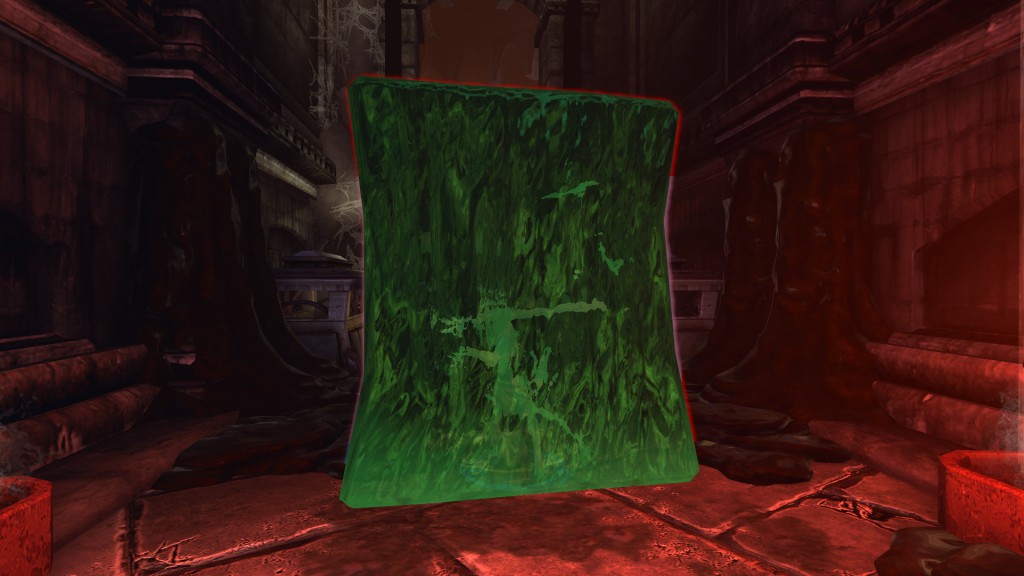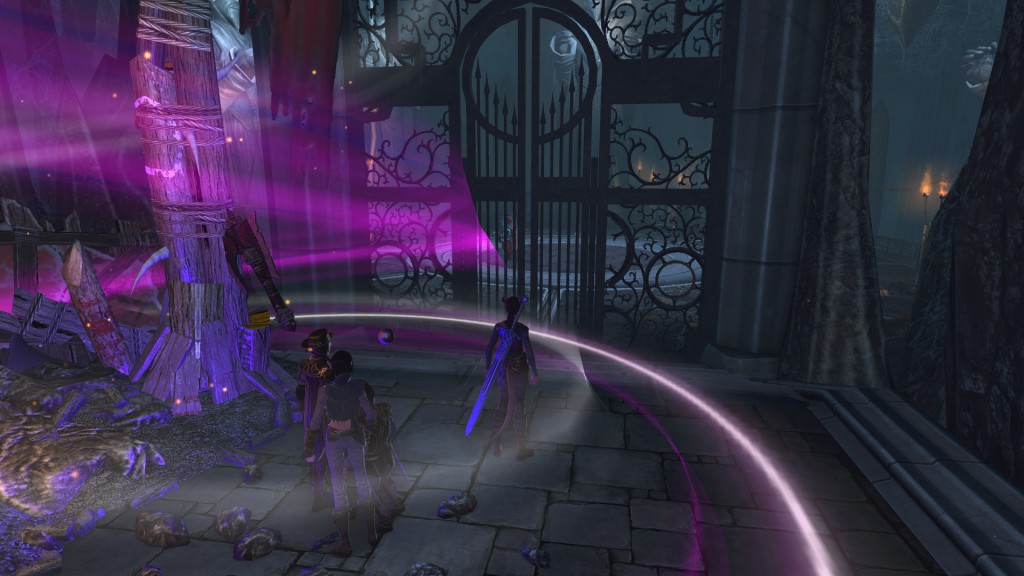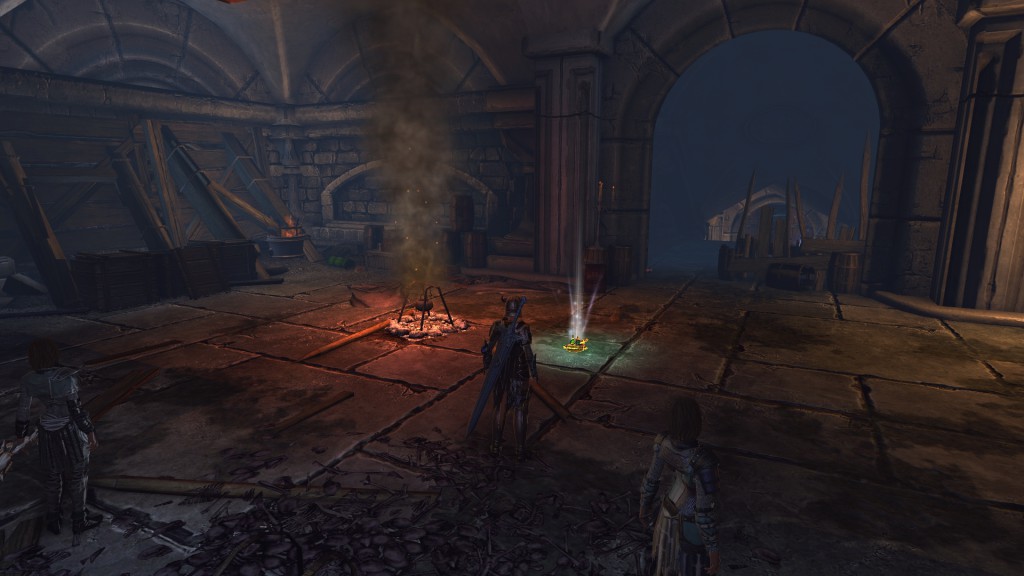Wizards of the Coast were really mean to Neverwinter when they released fourth edition. We’re talking full Sigil level, someone in the dev-team just doesn’t like you, burn to foundations and salt the earth, Robin Hobb protagonist levels of mean. With the world shattered by itself, it was personally visited by apocali and, at the beginning of Cryptic’s new Free to Play MMO “Neverwinter” it is under attack by an evil necromancer in highly impractical armour, atop an undead dragon, with her hordes of equally undead zombies and other things. You are the only competent person in the entire area, so it’s now your job to fix everything, one area at a time.
It’s D&D4 mapped to an action-adventure MMO engine, mechanically, with everything sped up. At-Will powers map to left and right mouse buttons, Encounter powers to rapid cooldowns, Dailies to something akin to Final Fantasy Limit Breaks, where fighting gains you Action Points you can spend on making a very loud, destructive bang.
Some traditional D&D mechanics are twisted for traditional MMO mechanics, like the Dungeoneering skill which allows you to mine some of the craft-item notes you will find, where Nature or Arcane will allow you to use others. More usefully, Dungeoneering will find you shortcuts in some missions, Nature will advance you in others. Skill checks also come up in conversation, but rarely.
As a game, it’s a decent enough MMO. The missions flow well and vary enough to keep life interesting, levels come fairly thick and fast as you repair each area of the city in turn, each area finishing off a weaving storyline of Kill-X-Rats, Find-X-Glowies, Protect-X-From-Harm area missions with instanced areas ending in a large boss. Combat is viceral and kinetic, with a number of Big Hit animations to dodge, warnings of area-effects to keep out of, and special skills (both yours and theirs) to trigger and watch out for. At the end of each zone the story is wrapped up save some loose ends, which clear up in a multiplayer dungeon.
If you don’t have a guild in play, or enough friends playing to put together a team, the queue system for the various requires-multiplayer bits works well enough, allowing you to play on until it has enough players to go for the thing you asked for.
The game is pretty enough, and well animated. The areas are well realized, if a little generic (This is a graveyard. Yonder is slippy slidey ice world, and afar is The Forest Where There Are Werewolves), and draws upon the rich world of D&D 4th edition, including mind flayers, Beholders, and the king of the esoteric monsters, the Gelatinous Cube
The problem is that it doesn’t matter. None of it matters. There is no… effect on the world. You go off on an adventure in a new area, you complete the soloable missions, you group the skirmish, you mob up and defeat the dungeon… you collect the box and move on to the next zone, which has no relation to the previous one at all.
The overarching story pokes in a couple of times, and it’s all against the giant world-defining backdrop of the spellplague and the rest of the state of the D&D universe, but apart from a couple of NPCs who reappear later in the game, there’s no feeling of the greater world at any point. Areas are self contained, and no choice that you make in one will ever move over to the next.
There’s an argument in MMO design between Sandboxes and Theme Parks, where in a Sandbox you can go anywhere, do anything, and you find the stories you find when you get there. In a Theme Park, you get on a ride, which takes you around on fairly static rails, and drops you at the exit point handy for the next ride. Neverwinter feels more like the latter paradigm than anything I’ve played in depth before, and while it means the plot and story are easily followed and the path before you is obvious, it seems ultimately shallow.
Even the area plots, the evil big bad guys who have taken over what ever area you’ve fought, don’t have much depth behind them. The game falls into the trap of putting all the character exposition into either mission text – and there are some astoundly badly acted ones – or optional “journal” entries of walls of text. The ability to *interact* with the major villains in any way that isn’t sword first would benefit the game hugely and give you a context as to *why* they must be destroyed, save the reason that their name’s red and they have a health bar.
That said, the gameplay itself is fun, and while the basic attacks you have on any class don’t change a lot over the run, your build choices over the course of the game affect your role dramatically.
Do It Yourself
The biggest new feature of the game, though, is the Foundry. City of Heroes – one of Cryptics’ previous MMOs – included a custom mission generator which was very much the ability to put your own parameters, characters and mission text into a procedural mission generator and play the results. The Foundry is an advance on this, more like the Neverwinter Nights Aurora engine in scope, with the ability to define your own environments and characters from any of the monsters in the game. As you play the MMO, you gain access to deeper aspects of the Foundry, new maps, new enemy types to use.
There are some astounding missions in the Foundry, stories that stretch the edges of the mechanics of the games, that tell vast overreaching stories of good and evil (with you on either side); Comedy goldmines that use the fantasy engine to tell stories of secret agents and nuclear secrets; Badly written gore-waders where every second apostrophe is three words from where it was needed. The discovery tools of the Foundry are decent, but I worry about discovery of new content as much as the burying of last weeks’ classics under an avalanche of the new.
The game is, arguably, worth playing for the Foundry alone, and I hope that some of the grand epics started – which eclipse the “main” storyline in scope and depth already – can come to a satisfying conclusion.
Raising Money
The game uses Perfect Worlds’ cross-game currency, Zen. Some things are sold for Coin, some for Astral Diamonds, some for Zen. You can convert Diamonds to Zen and vice versa, though the rates are astronomical, and you can earn Diamonds in play by the tens of thousands. In theory, this means that anything in the shop is buyable by just playing the game. In my experience, normal gameplay will net you enough Zen to keep you in keys to open Lockboxes (Random loot drops which can only be opened with Zen bought keys) and very little more. The higher level Companions all seem to be Zen only, and while there’s nothing in the shop that could count as being “Pay to Win”, the fact that I’ve only ever seen inventory bags purchasable by Zen makes me consider it an annoyance tax. Nothing in the shop is required for you to play the game, but getting a decent companion by play only is a grind to make a windmill go on strike.
Arts & Crafts
The game has a number of features I like a lot. It takes from SWTOR the abstracted crafting system, where you set timed tasks and they happen in the background. So far in the background, in fact, that you set and collect them on the website without entering the game at all. The same website gives you game mail and auction access, and this is all useful to keep you “Playing” the game even when you’re far away from your gaming rig.
That said, the level flow of the crafting game seems odd. At level 48ish, I’m still not producing anything within thirty levels of being useful to me, save the XP it gains.
And the end
The game is worth playing. For starters, it’s free to play, and there are no content restrictions on that. You can go from 1-60 without ever touching the Zen store, and while dropping some cash will grease the rails a bit, it doesn’t approach the sector of Pay to Win. The community isn’t too dickish, though it’s not perfect, and there are some awesome things happening in the Foundry.
If you give it a try, I’m on Beholder, and my global nickname is @Jascain.









